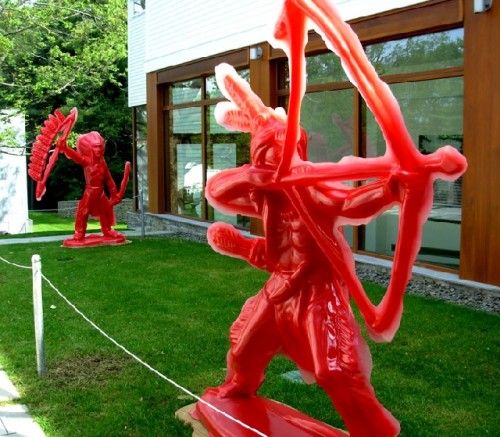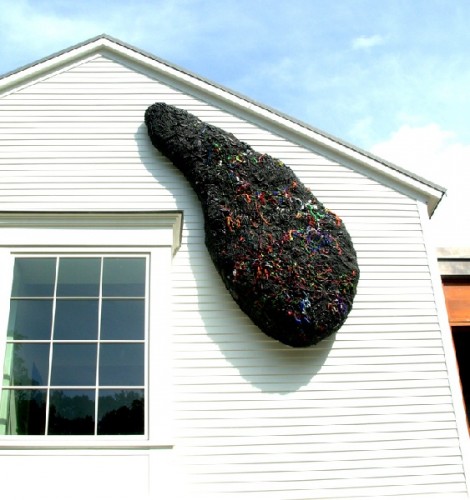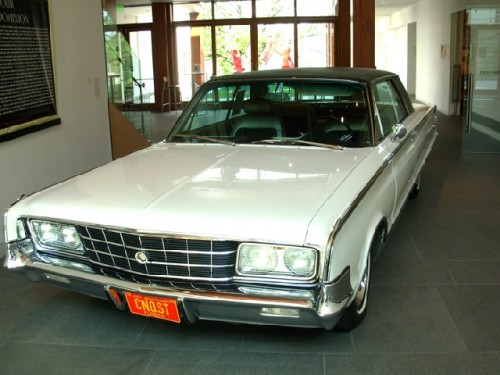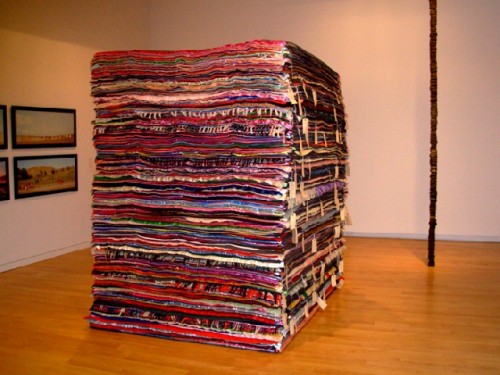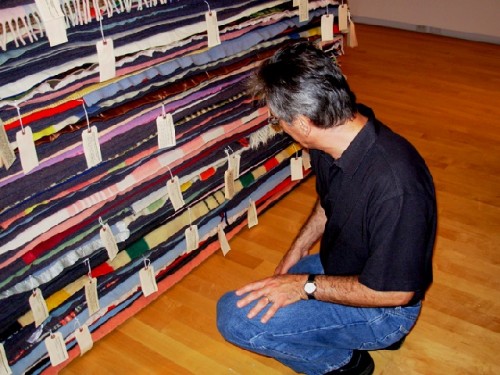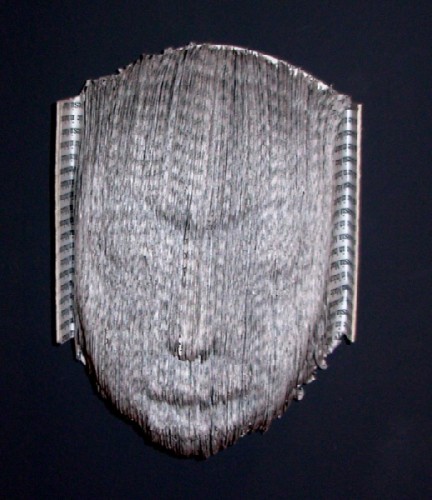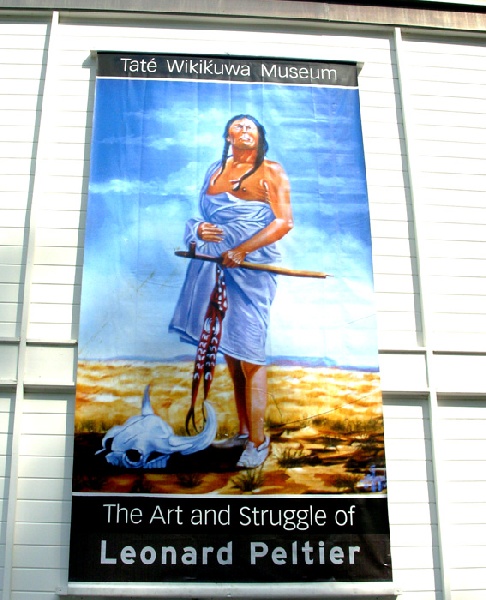The Aldrich Museum Combines Native and Non Native Artists
Fast Forwarding When Hemispheres Collide
By: Charles Giuliano - Sep 13, 2006
No Reservations: Native American History and Culture in Contemporary Art
Curated by Richard Klein
The Artists: Matthew Buckingham, Lewis deSoto, Peter Edlund, Nicholas Galanin, Jeffrey Gibson, Rigo 23, Duane Slick, Marie Watt, Yoram Wolberger, and Edie Winogrand.
Catalogue with essays by Klein, as well as Paul Chaat Smith, and Fergus M. Bordewich
The AldrichContemporaryArt Museum
258 Main Street, Ridgefield, Connecticut
August 23, 2006 to February 25, 2007
The exhibition "No Reservations: Native American History and Culture in Contemporary Art" curated by Richard Klein for the Aldrich Contemporary Art Museum in Ridgfield, Connecticut, about a one hour drive from Manhattan, may prove to be one of the most unique and influential projects of the season. The strategy and critical thinking of combining cutting edge work by emerging native and non native artists treating controversial issues of history and culture related to the legacy of indigenous people, is a landmark and template for future efforts.
It is particularly significant that this provocative exhibition is being staged in Connecticut on what was clearly once Indian soil. There is a social, political and economic resonance, which the curator has been inspired by and responded to, in the phenomenal enrichment of ancestors of the all but annihilated (during Colonial times and the first victims of deliberate attempts at genocide by European settlers) Pequot and Mohegan nations. They have established on reservation land two of America's largest and most successful casinos; Foxwoods and Mohegan Sun. The creation of casinos all over America on tribal land has led to an empowerment of native people and the ability to function as significant players in the game of American capitalism. It has provided the option to literally buy back and reclaim precious land and natural resources which were stolen from them.
This is not to imply that the recapitalization of tribes that have suffered centuries of oppression and theft is any panacea. The vast majority of native people on and off the Rez continue to live in poverty with a daunting range of issues from health care to education, employment, housing and relief benefits. There are very real struggles among tribes between the haves and the have nots. There are tough issues of identity particularly the percentage of blood ancestry that varies greatly among tribes. Within the Indian community there is conflict between the primarily urban dwelling Eastern tribes and those embedded into traditional cultures and values living on the reservations of the South West. The media in Connecticut has followed the struggles of the Schaghticokes who have lived continuously inLitchfieldCounty since the 1680s. Several years ago they were officially recognized as a tribe by the Bureau of Indian Affairs. When it was realized that this would enable the tribe to build a casino in Danbury, virtually in the shadow of the Aldrich Museum, there was alleged tampering by local interests which may have included wealthy residents, the Kent School, which abuts and may sit on ancestral land, and the interests of the Foxwoods and Mohegan casinos which were concerned about encroachment on their business. Under murky circumstances, now in litigation, the BIA, for the first time in its history, reversed its decision and stated that the Schaghticokes cannot prove that they are a tribe. All of the above stated issues and concerns are brilliantly examined in the catalogue essays by Klein, Paul Chaat Smith and Fergus M. Bordewich.
So Klein's exhibition addresses a far more complex and daunting agenda than simply presenting the work of ten contemporary artists. The crucial point is whether he has managed to pull off such a multi valent project with its elements of political, social and economic history, indeed the very essence of Manifest Destiny and all of its horrors, and still conflate as a compelling exhibition and primarily visual experience. Given the vast ambition and detail of such a broad undertaking it would be inaccurate to state that Klein's project has been completely successful. There are just too many tangents and loose ends to tie together neatly. So we are confronted with a kind of Gordion Knot conundrum and perhaps the best and Alexandrian approach is not to unravel the tangled knot but simply slash through it with a sharp sword and swift blow.
During a touri of the exhibition with the curator and discussing the project (which I will report on separately) he expressed interests and motives with precision and insight. There were moments of passion conveying misgiving during the development of the exhibition when he reflected that he was "in over my head." It is precisely for this reason that I have so much respect for him both as a curator and a humanist. He took on a seemingly impossible task, sorted through all its tropes and traps, shoots and ladders, dungeons and dragons, and assembled a coherent project that makes a lot of sense. Let us hope that his success and moral fortitude encourages and emboldens other curators and museums to undertake serious inquiries into the egregiously neglected field of contemporary Native American art.
Yes there are museum level exhibitions of contemporary Native American art but these primarily occur at institutions which are dedicated to the material. There are occasional solo exhibitions at mainstream museums of established and midcareer artists but there is no consistency or agenda to this programming. With so few non Native curators and critics taking on this material the efforts become greatly magnified and scrutinized particularly within the native community which tends to be both guarded and divisive about its cultural heritage, belief systems and rituals. The essays in the Aldrich catalogue make inevitable comparisons to the progress of African American art and Chinese conceptualism in breaking into the mainstream of the art world. But the issues, particularly regarding identity and tribalism, federal recognition and sovereignty, render moot such comparisons.
Everyone close to the issues agrees that is it just a matter of time before individuals or groups of emerging Native artists break through into the mainstream. Once there are Native art stars, as there are among African Americans and Chinese conceptualists, for example, we may anticipate the inevitable sea change. It is argued that this already exists in the Canadian art world. But this is still such a minority subculture that, while progressive, offers little significant impact on the mainstream. It is just a matter of time, however, before a handful of Native artists begin to appear in feature articles in the major art publications. But this also implies that young, savvy, careerist Native artists are thinking long and hard about just how to handle the issue of their identity. Many of these artists are expressing that they want to be viewed as artists first and as Native artists second. Some go so far as to say that being included in group shows with other Native artists is not a good career move. Since the work is so little known and rarely seen there is still an imperative for such projects. We have not yet reached the vantage point where there is the luxury to abandon Native themed group shows on the all too rare occasions when they are presented by mainstream institutions. Perhaps that time will come. But it's not here yet. So Klein's strategy to combine five Native and five non Native artists is a clever and promising approach. Still, he was not able to include an important mid career artist, enjoying a level of success, despite having shown the work twice previously at the Aldrich.
While the exhibition would have clearly benefited by including the Native artist who declined the invitation Klein was successful in formulating and executing a game plan. He operated within some interesting ground rules. Most obviously, to break down the show as fifty fifty, half and half. The non Native artists are reflecting on aspects of the history and encounters between Natives and European settlers, a common legacy for all Americans. While the Native artists were selected on the basis of making contemporary, non traditional responses to their culture. None of the work in the show overtly "looks" Native. This conflates with the curator's agenda to make the audience reexamine their assumptions about Native culture that have been perpetuated by mistelling of American history in schools and the racist slurs of popular culture. His project refuses to play into aspects of New Age kitsch and consumerism in which too many Native artists make work targeted to misconceptions of the white audience. There are artists who have brilliantly targeted and deconstructed just that theme. But that would be another show.
Although the exhibition has been in the works since 2001, and Klein made a number of field trips and studio visits, he imposed the tough discipline of confining himself to just ten artists which allowed for the best use of the limited space of a small regional museum. He prefers to show a limited number of artists adequately rather than to jam in a larger selection of work. Although he states that given a larger space he might easily have shown twice as many artists the challenge was to select the strongest and most compelling work.
While I had met with and interviewed two of the artists, Duane Slick and Jeffrey Gibson, with the exception of the sculptures of Yoram Wolberger, the works of the other seven artists proved to be a delightful surprise. My only concern and disclaimer is that the several hours at the Aldrich, from mid afternoon through5:30 when the museum was closed and Klein had to make a UPS stop, went by all too quickly. There was just not enough time to fully encounter all of the work as well as interview the curator. In addition I wanted to view the unique installation in a temporary building of a large selection of new painting by the German artist, Anselm Kiefer. That important show, and another compelling reason to visit the AldrichMuseum, will be on view through October first.
Arriving at the museum I was pleased to see an ambitious new relief sculpture by Jeffrey Gibson, a biomorphic, beaded pod, in mostly dark color with flashes of high chroma highlights, attached to the façade of the building. It seems to have grown there planted by some gigantic insect from science fiction. By far it is the most ambitious sculpture to date by a New York artist who is represented by Samson Projects in Boston. The two paintings on display in the museum, in addition to the artist's first ever, free standing sculpture, represent truly astonishing progress. Stimulated by the opportunity Gibson rose to the occasion by creating new works that represent a career breakthrough. The two paintings, which typically combine surreal, floral inspired abstracted elements with silicone gel relief are far more integrated and resolved than has been the case in the past. There is a darker overall palette which seems better to contain and sustain the fantasy aspects of the imaginary flora and fauna. Which are based on encounters with land owned by his family since the 19th century. The silicone for Gibson's large external sculpture was donated by theConnecticut based General Electric Company.
Also attached to the facade of the museum, on the opposite side of the main entrance from Gibson's sculpture, was a large banner announcing "The Tate Wikikuwa Museum" a conceptual work by Rigo 23 which has been shown globally. In a gallery in the museum is a simulation of the prison cell in which the Native American activist and member of AIM (the American Indian Movement) Leonard Peltier has been confined for some thirty years for killing two FBI agents in a 1975 shootout at the Pine Ridge Reservation in South Dakota. Two other Native defendants were found not guilty on grounds of self defense. The simulated cell displays several representational paintings created by the inmate. Surrounding the cell are vitrines related to the ongoing struggles to free the prisoner who is serving two consecutive 25 year sentences. There have been numerous pleas for clemency by individuals from Bishop Desmond Tutu to the late Robert Kennedy. The stairs next to the second story gallery have been inscribed with the years served. He is eligible for parole in a couple of years.
In the lobby entrance to the museum visitors encounter a 1960s deSoto automobile created by the artist Lewis deSoto who ironically relates to both the Spanish explorer and conquistador as well as the Cahuilla tribe which operates successful casinos inPalm Springs,California. The artist was so frequently asked if he was related to the makers of the deSoto automobiles, a division of Chrysler which ceased in the 1960s, that he has painstakingly hand made an ersatz deSoto, by reconfiguring a vintage Chrysler. The stunning automobile, which the artist actually drives as a moving sculpture, has many sly and ironic features. On a side window where usually one encounters sticker information and specs on a new car the artist has translated and printed the statement, ordered by the Spanish crown, to be read to natives whom conquistadors encountered. Indians were forced to sign the document they could not read and therby agreed to convert to Christianity or suffer execution. Embrace Christ or die was its grim demand. In another gallery the artist is showing a pickup truck which extends the "Conquest" project. This crafty vehicle comments on the new wealth of his casino owning tribe. A sound track from the vehicle's radio system conveys traditional chanting overlaid by casino noise and the clanging and chingle of slot machines. The seat cushions are covered in fabric based on the web patterns embedded into American dollar bills. The work is all about the culture clash of newly rich traditional peoples.
Outside the museum, entered through the lobby into a courtyard, are two of the stridently racist, meticulously crafted, blown up plastic sculptures by the Israeli born artist, Yoram Wolberger. As a child, as kids do around the world, he played Cowboys and Indians with cheap plastic figurines. In this play the artist recalls that kids wanted to be the good guy cowboys and not the bad guy savages. Later war was not a game when as a young adult he fought the PLO inLebanon. Aspects of war and global conflict have informed his adult work and he derived the concept of making precise life sized versions of those plastic toys as a conceptual metaphor. On the second floor of the museum a blue cowboy aims and shoots down at the red Indians. War games. The artist now lives and works inSan Francisco.
The installation by the young Seneca artist, a recent graduate of Yale and an emerging art star, Marie Watt, is solemn and quietly compelling. She has created a stack of virtually hundreds of blankets. Some were donated by individuals who on luggage tags were asked to write a bit about the history of the blankets. One piece, chillingly, was provided by a Nazi death camp survivor. Most of the blankets are generic and were purchased from a company that makes them for prisons and homeless shelters. A crew of volunteers worked with the artist to sew ribbon borders which are visible as a rainbow edge to the stack of blankets that is about six feet tall. Nearby is an "endless column" in bronze of small scaled, "folded and stacked" elements which reach from floor to ceiling. It is an allegory for aspiring to the heavens while the stack of blankets are grounded to the earth. After the show the purchased blankets will be donated to shelters and distributed to the needy. It relates to the intent of the artist to create a sense of community by assembling the donated work and the labor of volunteers, bringing people together, and then a life beyond the installation when blankets are distributed and become useful to others. This connects to the ideas of Joseph Beuys and his concept of making Social Sculptures.
On the wall adjacent to the blankets is a double row grid of panoramic photographs of the historic reenactment of Custer's Last Stand and the Lewis and Clark expedition by Edie Winogrand. The artist discovered that there are in fact two, annual, separate Custer reenactments. One official and more elaborate one staged by the local town and another nearby on Crow land at the actual site of the Little Big Horn which is actually just a creek. Ironically the Crow served as scouts for Custer against their traditional enemy the Sioux. The Crow scouts survived the massacre because Custer had allowed them to disengage and steal Sioux ponies. So it is very contentious that Crow men impersonate Sioux warriors for the purpose of tourism. Winogrand's photos are compelling and brilliant.
Als In this gallery are works by the Native artists Duane Slick and Nicholas Galanin. The pages of Slick's resin encased book "Looking for Orozco" in which the artist's alter ego Coyote encounters the life and work of the Mexican muralist, Jose Clemente Orozco, whose spirit "burns like fire" as well as "Coyote Considers Pollock" have been disassembled and attached to the walls with metal brackets. They cover the length of the wall and one views the "pages" obliquely. Further on, in a niche before the next gallery, is a single white on white silhouette, frontal, male figure, arguably, a muted and layered self portrait. It may relate to the artist's reluctance to reveal a guarded identity as he straddles two worlds. There is a somewhat similar agenda in the works of Galanin. He "carves" traditional masks in relief by subtracting from thick books on the anthropology of his Alaskan culture. It conveys the notion that the "truth" in the form of a traditional image is "revealed" by cutting away the obfuscating layers of the research and writing of a non Native anthropologist. Next to these pieces is a video monitor which in a fifteen minute cycle bombards the viewer with an assault of images of traditional objects. It is an allegory of the impossibility of assimilating such a glut of images of archived materials. That just to see the objects is not to know the culture.
Peter Edlund appropriates historic 19th century American landscapes, such as Thomas Cole's "The Oxbow" but alters them by rendering the iconic works in an acidic green monochrome. Ironic details are added which deconstruct the benign intent of the original works. In "The Oxbow," for example , stuck into a stump is a knife, a reference to the American president Andrew Jackson and Indian fighter who was called "Sharp Knife" by his primary victims the Cherokee. At roughly the time of the Cole paintingJackson was attempting to annihilate and relocate Indians so their rich land would be available for white exploitation. We also encounter rape scene vignettes in seemingly benign copies of the Western paintings of Albert Bierstadt.
In a work by Matthew Buckingham, Mount Rushmore has been literally "defaced" of its signature, four, monumental portraits of great American presidents: Washington, Jefferson, Lincoln and Teddy Roosevelt. The artist has fast forwarded in geological time to when the sculptures will theoretically erode to oblivion. The image is displayed in a narrow corridor space next to which are dates and time line incidents marking moments in Native history and encounters with Europeans. I did not have time to read this intensive material but Klein reports encountering visitors absorbing the fine detail. Also I opted not to view the artist's film as I needed time to interview the curator.
Because of the limited encounter with the work I would rate this review as an "incomplete." It is at best a work in progress. Undoubtedly there will be feedback, positive and negative, and that will stimulate further thinking. My greatest concern, which we will pursue in the report on the interview with Klein, is that this seminal project is both a brilliant beginning and, for now, sadly, an end. Describing himself as a "generalist" working for a small museum with its related pressures the Aldrich has no plans to follow up on this exhibition with additional Indian themed shows. And there appear to be no other museum offers on the table. It seems that engaging in and writing about contemporary Native art is, well, a bit of a crap shoot.

